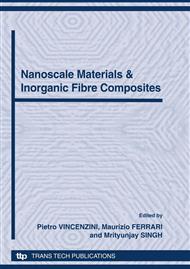p.45
p.50
p.58
p.68
p.74
p.80
p.86
p.92
p.102
The Ballistic Impact Characteristics of Woven Fabrics Impregnated with a Colloidal Suspension and Flattened Rolls
Abstract:
This research investigated the ballistic impact characteristics of KM2 Kevlar fabrics and Dyneema UD for personnel body armour using two stage gas gun. The neat KM2 Kevlar fabrics were compared with those impregnated with shear thickening fluid(STF) which showed to absorb much energy up to a velocity of 300m/s. Also studied are the effects of projectile shapes on the energy absorbing in fabrics. We observed that the fiber pull out distance without breaking is important for ballistic energy absorption. We devised an efficient ballistic energy absorbing mechanism at high velocity range by adopting flattened roll design of Dyneema UD. The suggested hybrid design composed of flattened roll and KM2 fabric impregnated with STF with stitching had advantage of 15~20% areal density reduction compared with neat KM2 fabric design.
Info:
Periodical:
Pages:
74-79
Citation:
Online since:
October 2010
Authors:
Price:
Сopyright:
© 2010 Trans Tech Publications Ltd. All Rights Reserved
Share:
Citation:


